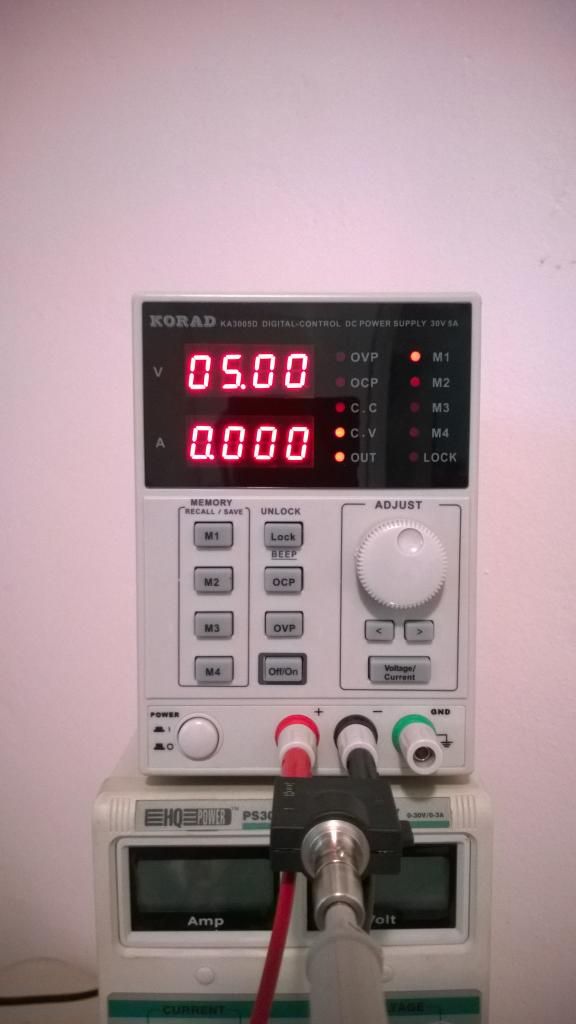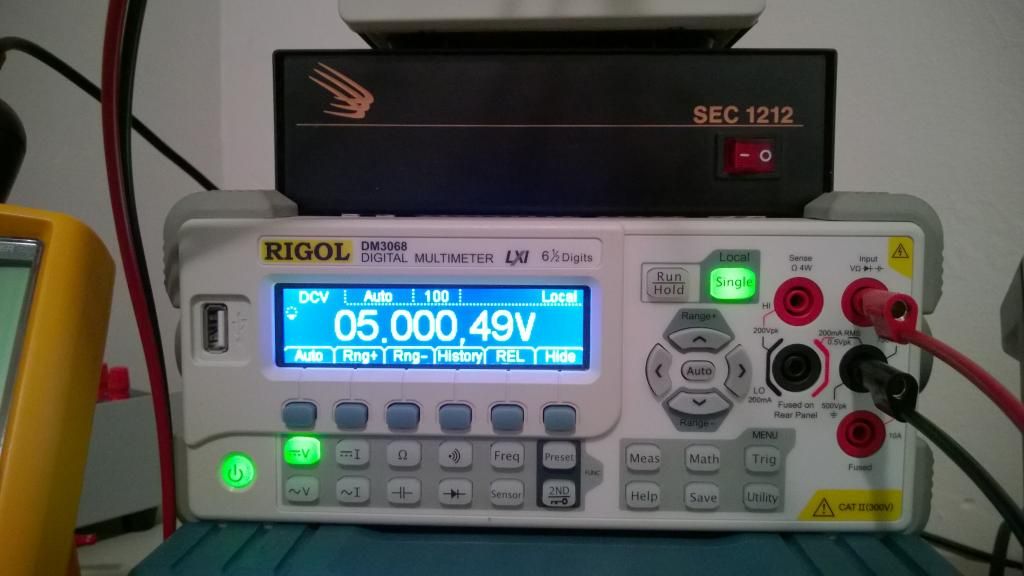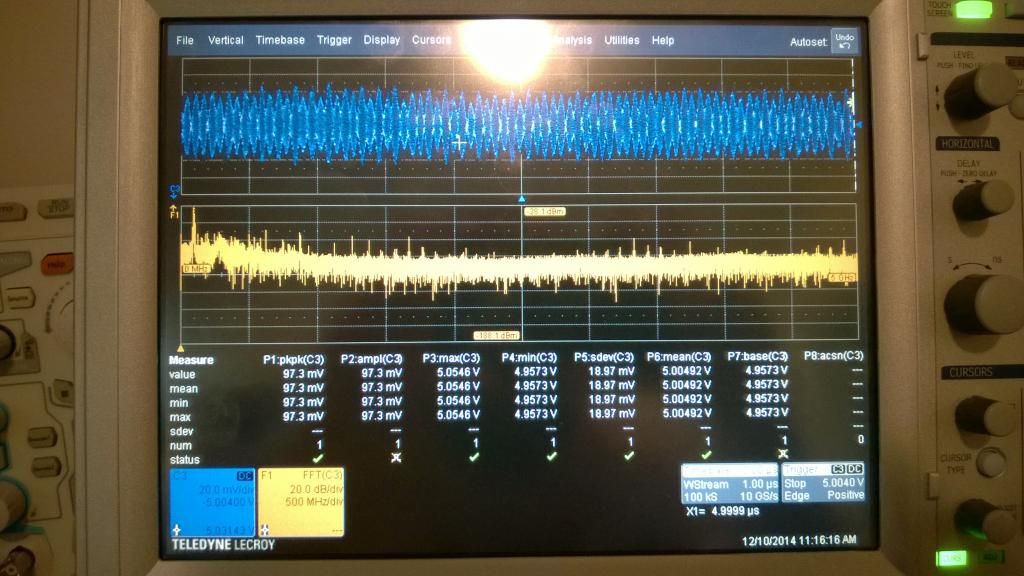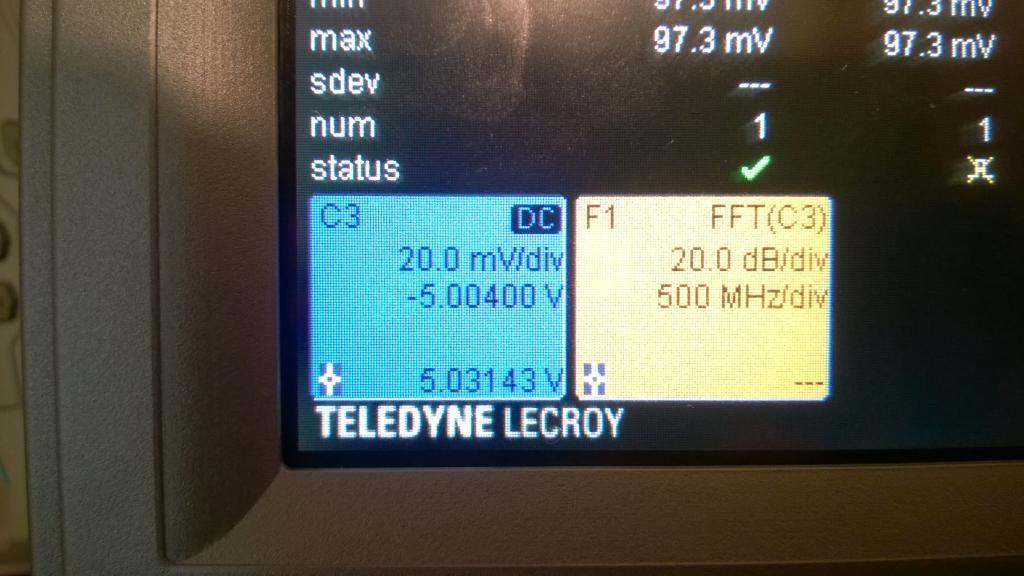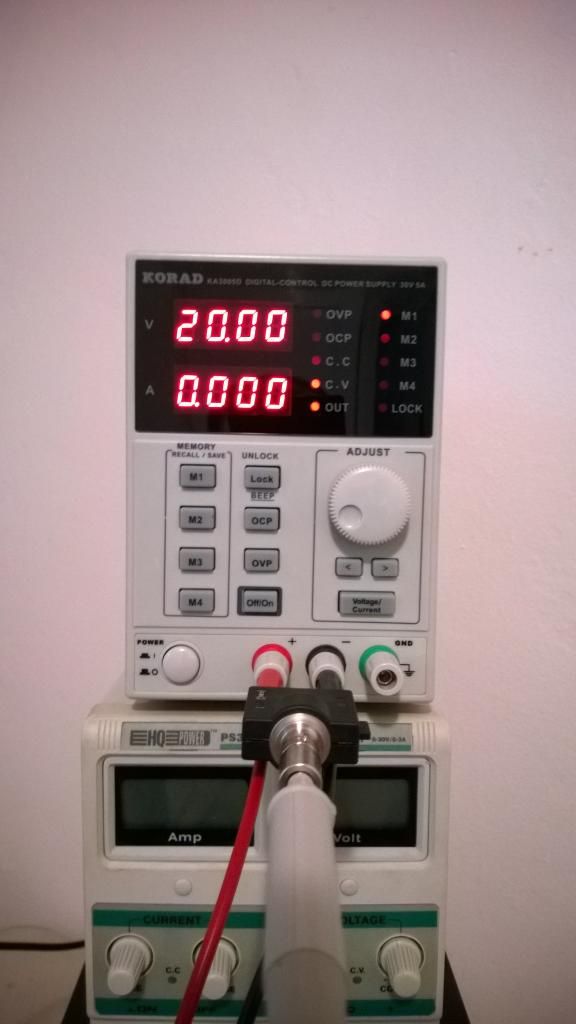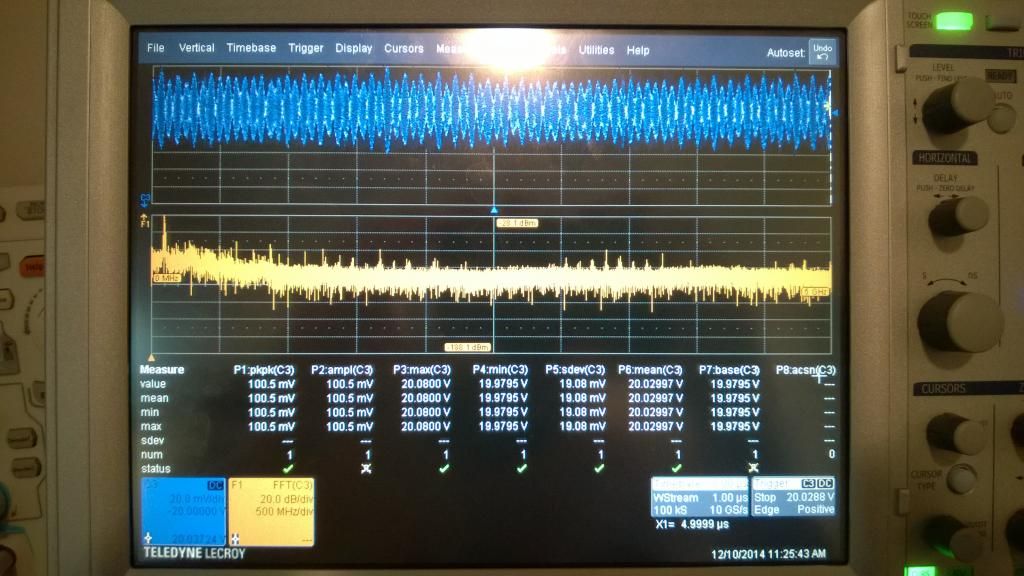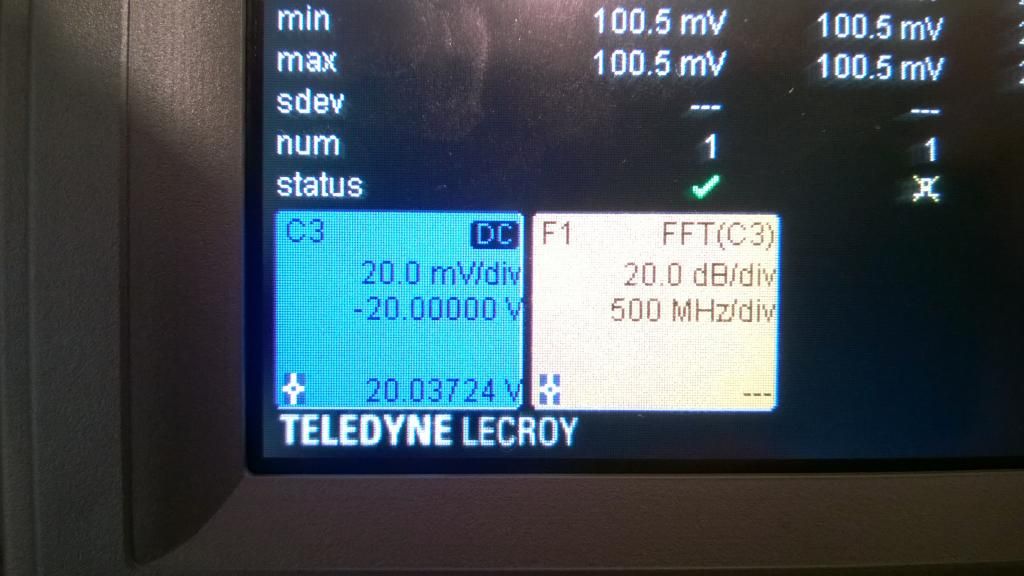-
In the simulation you can clearly see a predicted response curve.....which is partially represented in the real wold....BUT have a look at the HF energy which the simulation missed.
IMHO that is due to the limited model you are using for the simulation. One of the things I like to simulate are worst case conditions which often reveal hidden problems. A 'crappy SMPS' is not very scientific
This problem is compounded with a dynamic load (I will simulate that on the next experiment).
I purposely use crap power supplies for these tests....to see how input phase/ripple changes the dynamic responses of the POL under test. It's great to have a collection of crap SMPS and linear PSU's. Feeding precise, filtered signal into the POL front end is a terrible way to test these devices. In the real world we have to assume that our hardware is being connected to crap wall-warts or similar. I can also run this experiment using a battery, with both high and low margining. You will see just how far off the predictions are from the real world response
Once again, you are missing the boat here.
Number one, I didn't include screen shots of the entire simulation....only it's predicted output. i would think if you had simulation experience that you would assume the simulation is complete? Do you need screen-shots of the other 5 pages of parametric simulation? Isn't the predicted response enough?
Also you are failing to realize that the circuit in test is in fact a VERY high quality (really bleeding edge) DC-DC POL. It's being fed by a less than ideal IBV, to try and gain insight on what happens to a tightly regulated POL, when it's input drive is less than ideal.
You are jumping to conclusions again. This is a pattern you are displaying. I am not trying to be rude here, but you are continually making assumptions. That is my entire point here in this thread. You can't make assumptions about your predictions or what "should" happen.....and then limit your tools to only measure your predicted deviations. I hope you see the pattern emerging, on your end, and look at it carefully. It's a very solvable "bad habit".
Would you like screen shots of the other components of the simulation? coming up... -
While not true in all cases, my experience in ME was that by the time I created a suitable model for a simulation that was to be believable - I could have built and destructive tested it a few times already which gives me the ultimate answer. Even after a good simulation has been built and analyzed, you still have to built and delicately test the circuit to confirm and look for anything unexpected. If there is any truth in that - why/when bother with simulation?
I too test with "crappy SMPS" sources to learn how my circuit deals with a variety of non-ideal situations. It seems that simulating and scientific analysis [guessing] would not be nearly as good as throwing the real world at it, right? I have not spent much time understanding my own definition of 'crappy' simply because my customers wont or cannot adhere to that - if my device says '12v IN' and their random SMPS says '12V OUT' - they will simply plug it in and expect it to work. I can setup a test with a variety of DC sources and examine the resulting performance impact on my circuit.
Is this a logical fallacy, or a reasonable way to go about it? Maybe use a simulation to set a baseline to measure from?
Trust me, you are doing it right.....simulation is great for early development of VERY complex systems. It is a large waste of resources, on small run, quick to market ideas though. NOTHING beats whacking together a basic prototype and measuring it, against your models and predictions.
I personally simulate up to a point, but very quickly abandon the simulations and focus on reality. Simulators are getting better every day, but they aren't a substitute for putting the right tool on a live circuit, with a live load (dynamic).
Why spend months building and debugging a simulation, on a circuit I can whack together in 2 hours? I can see the benefit in a system, where you are dealing on macro scales of complexity.....but the stuff you and I are doing (albeit complex in theory) is very easy to assemble and throw some proper test gear on. -
You keep dumping loads of incomplete information without getting your point across. I'm pretty sure you know what you are doing but to me you seem like a professor who is exited about his area of expertise but is just mumbling and writing incomplete equations on the black board. You are writing about a 50mV overshoot; that can be relevant for certain loads but all the equipment in your pictures doesn't show that overshoot hence there is no evidence in your pictures to justify the test setup you are showing. Let's keep the discussion more generic instead of focussing on one niche area of circuit design.In the simulation you can clearly see a predicted response curve.....which is partially represented in the real wold....BUT have a look at the HF energy which the simulation missed.
IMHO that is due to the limited model you are using for the simulation. One of the things I like to simulate are worst case conditions which often reveal hidden problems. A 'crappy SMPS' is not very scientific
This problem is compounded with a dynamic load (I will simulate that on the next experiment).
I purposely use crap power supplies for these tests....to see how input phase/ripple changes the dynamic responses of the POL under test. It's great to have a collection of crap SMPS and linear PSU's. Feeding precise, filtered signal into the POL front end is a terrible way to test these devices. In the real world we have to assume that our hardware is being connected to crap wall-warts or similar. I can also run this experiment using a battery, with both high and low margining. You will see just how far off the predictions are from the real world response
Once again, you are missing the boat here.
Number one, I didn't include screen shots of the entire simulation....only it's predicted output. i would think if you had simulation experience that you would assume the simulation is complete? Do you need screen-shots of the other 5 pages of parametric simulation? Isn't the predicted response enough?
-
Here are some more thorough screen caps of the entire simulation.....I assumed that most folks would only care about the output result....but I can see that is not the case. There is simply NO better simulator available for this specific circuit. This simulation is built by the component level manufacturer, and is literally as good as we can hope to get...for this specific scenario.....
This is NOT the actual simulation of the response in the test I showed above. I couldn't be bothered to repeat the entire experiment, but let's assume all of the simulation values were filled in correctly for the prior test (as they were). The predicted step-response and margining in the prior test, simulated to below 5.5V output (in both AC/phase and DC step response). These are random values (defaults).
My point here is not to teach how to simulate and measure this specific circuit....rather it is to show that predictions, simulations and assumptions are only as good as the data your test can back them up with
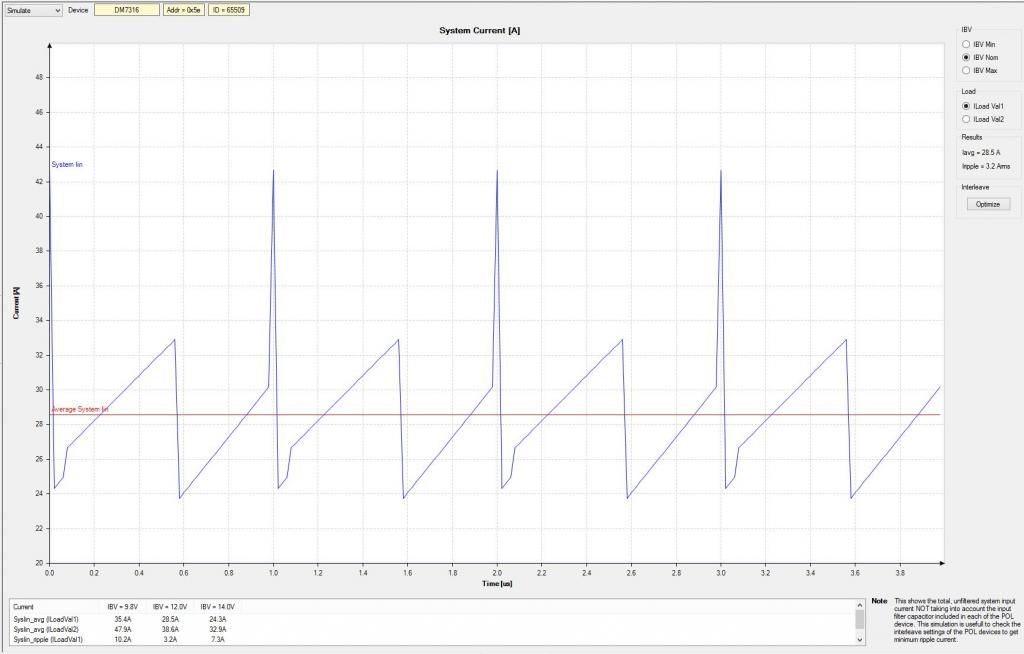

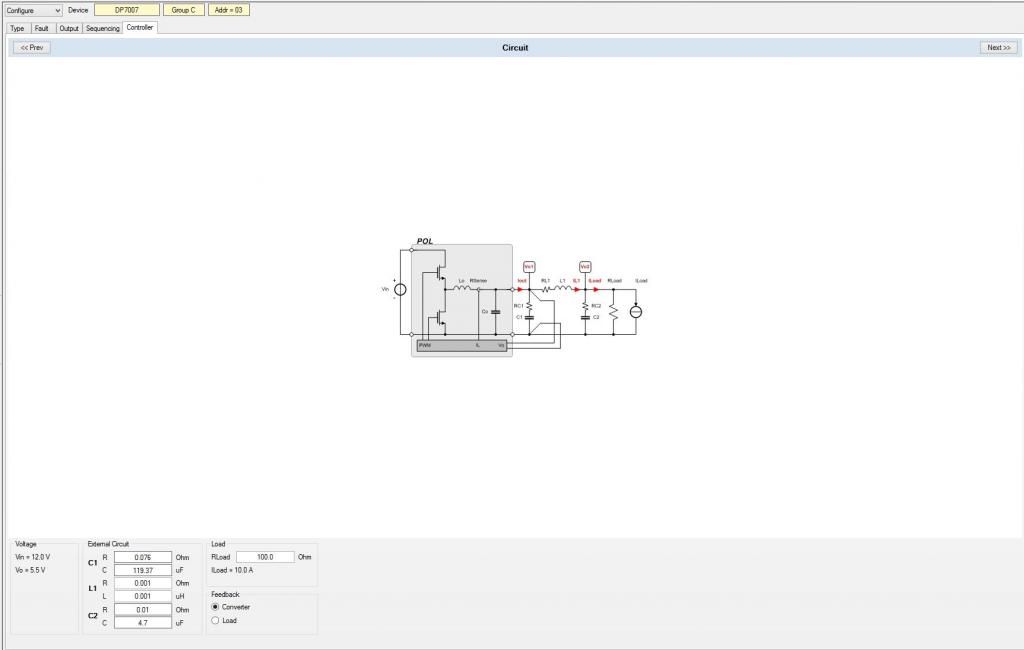
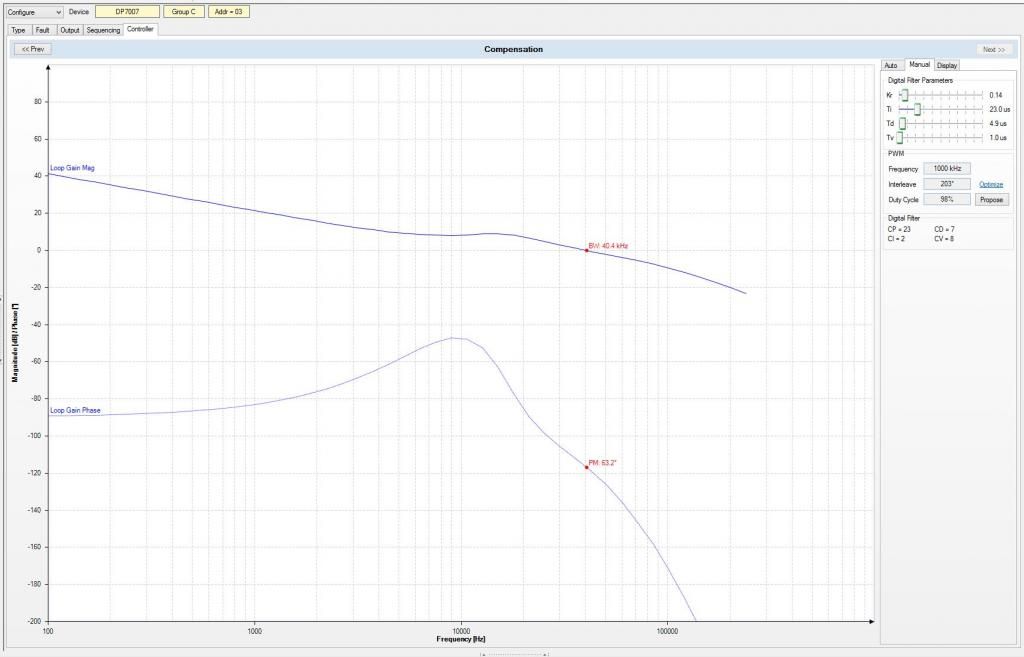
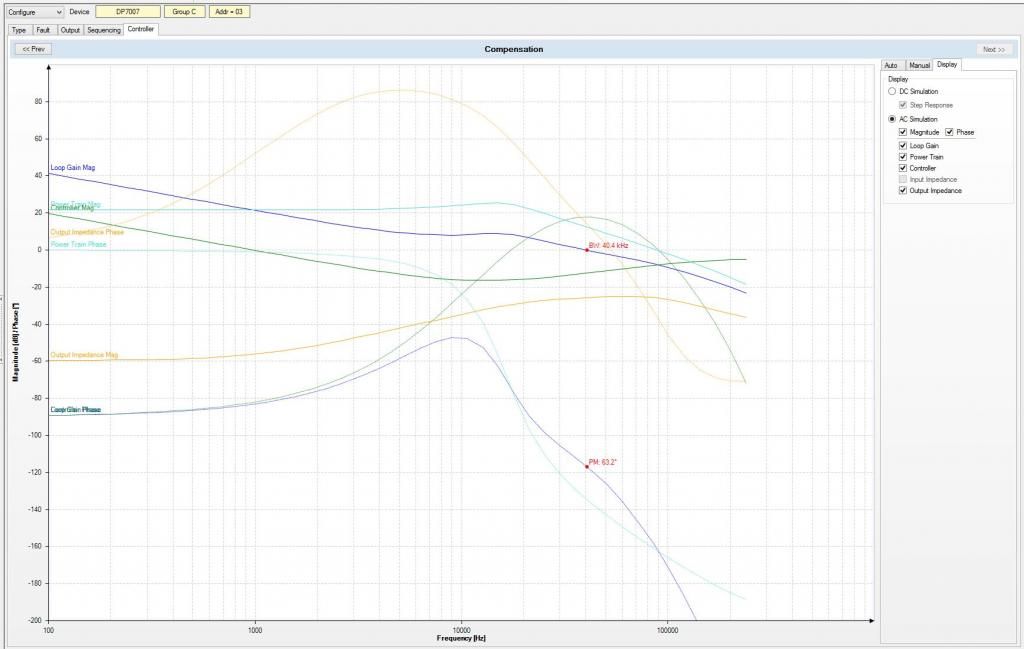
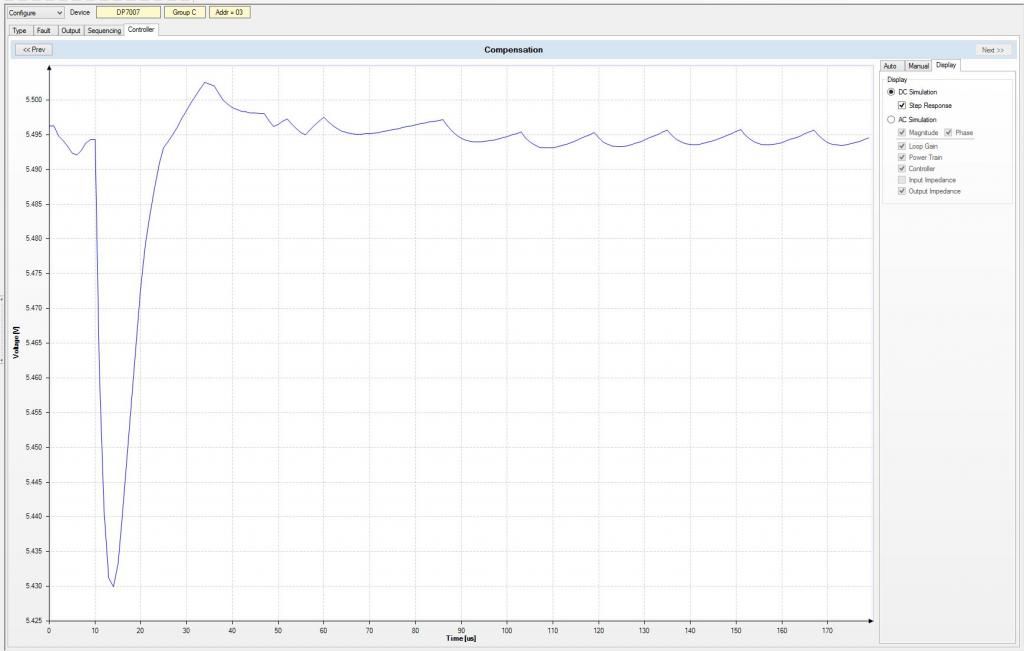
-
You keep dumping loads of incomplete information without getting your point across. I'm pretty sure you know what you are doing but to me you seem like a professor who is exited about his area of expertise but is just mumbling and writing incomplete equations on the black board. You are writing about a 50mV overshoot; that can be relevant for certain loads but all the equipment in your pictures doesn't show that overshoot hence there is no evidence in your pictures to justify the test setup you are showing. Let's keep the discussion more generic instead of focussing on one niche area of circuit design.In the simulation you can clearly see a predicted response curve.....which is partially represented in the real wold....BUT have a look at the HF energy which the simulation missed.
IMHO that is due to the limited model you are using for the simulation. One of the things I like to simulate are worst case conditions which often reveal hidden problems. A 'crappy SMPS' is not very scientific
This problem is compounded with a dynamic load (I will simulate that on the next experiment).
I purposely use crap power supplies for these tests....to see how input phase/ripple changes the dynamic responses of the POL under test. It's great to have a collection of crap SMPS and linear PSU's. Feeding precise, filtered signal into the POL front end is a terrible way to test these devices. In the real world we have to assume that our hardware is being connected to crap wall-warts or similar. I can also run this experiment using a battery, with both high and low margining. You will see just how far off the predictions are from the real world response
Once again, you are missing the boat here.
Number one, I didn't include screen shots of the entire simulation....only it's predicted output. i would think if you had simulation experience that you would assume the simulation is complete? Do you need screen-shots of the other 5 pages of parametric simulation? Isn't the predicted response enough?
You have got to be kidding?
The overshoot is CLEARLY shown on the scope....and it's shown as HF in nature. I am not a professor.
Are you being serious here? Or just trolling? I am dumbfounded by your responses.....
The completeness of the experiment is FAR above and beyond ANYTHING you have provided. As you have provided NOTHING but inexperienced ramblings, in reply.
How can we keep a discussion "generic"....when the OP proposed SPECIFIC criteria?
Hoe much more specific do you need this to get? Just because you don't understand the results....doesn't mean the problem is on MY end....like I said you are throwing generalizations out, with NO data to back them up.....on a VERY specific subject....here is your overshoot
If YOU don't understand my point....then it's because you either can't interpret the data, or you aren't reading the entire responses.....
The point has been, all along (and emphatically overstated) that 100 MHz front end, is going to MISS critical step response event, in multi phase architectures....it's clearly happening in a SINGLE phase architecture.....that my experiment is based on.....
Would you like me to post a more complete experiment on a multi-phase system? I am trying to help OP develop his requested criteria here.....not teach a class on how multi-phase DC-DC systems work, and their possible pitfalls....if you would like me to do that make a new thread. I am just here trying to help someone answer their original question, on the basis of experience and insight (that goes beyond most industry ramblings and marketing)
I have made NUMEROUS suggestions, in answering the OP's criteria requirements.....SPECIFIC suggestions. Instead of making suggestions about scope criteria, YOU have gone down the path of simulation (which has nothing to do with scope criteria) and then accused me of taking this "off topic". How am I taking it off-topic, by showing real world use case scenarios, for a 400+MHz front end (in relation to DC-DC regulation), while YOU are going down the road of simulations?
Can you give OP a reason why (or why not) my suggestions for 400Mhz (or more) of bandwidth are useful to his needs? I am showing why with real world experiments....and you are talking about circuit simulation....
In this picture you can clearly see the circled are of the FFT (to the left) which the simulator predicted.....(have a look at the response charts again if you missed it). On the right you can clearly see HF content that was not predicted. In the waveform you can clearly see that the HF content is causing the control loop (vsense coupling) to cause a switching overshoot, that measures ABOVE the predicted range in the simulation...the ripple shown, which is more frequent (brighter part of the trace) is well within the spec of the system......the overshoot event is NOT....and if I didn't loosen up the over provisioning specs in the controller, it would have caused the entire system to turn the POL off....
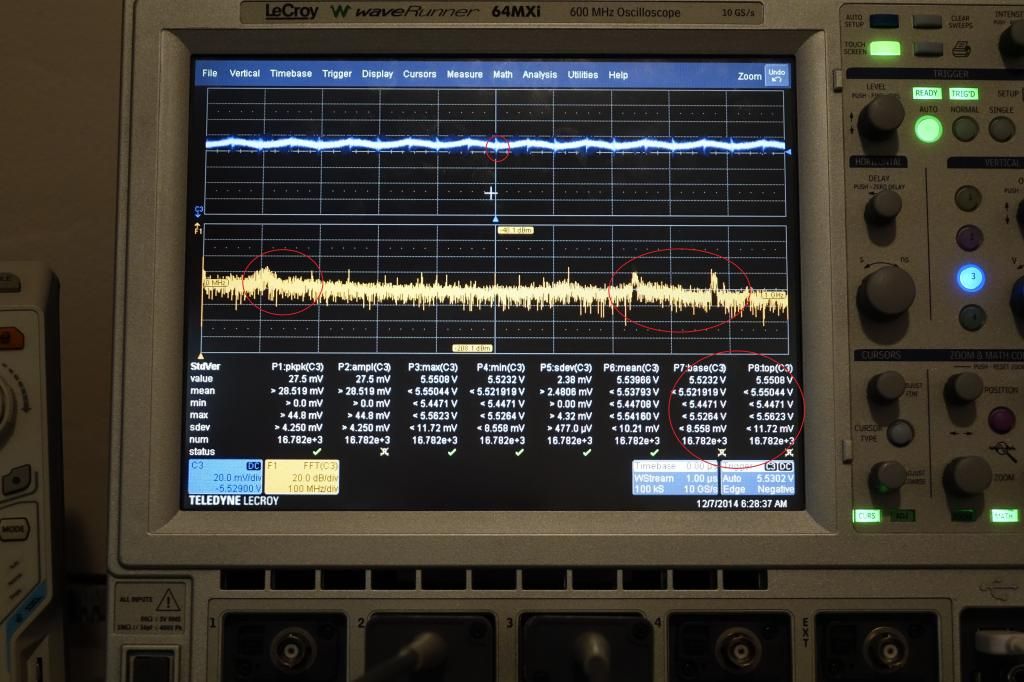
-
Let's have a look at the output set points of the POL and controller.....
You can see that the load regulation ABOVE 9 amps is set for 1.05mV/A....and that the target out is set for 5.5 V.
So then why does our scope pick-up 5.55044 V peak? Despite the POL margining the output above 9 amps?
The POL should be outputting 5.5 V - 9.45 mV. It's clearly NOT.
This is because the capacitance of the v-Sense (which is controlling the feedback control loop) is incorrect. Despite the simulation and predictions saying it "should be good enough".
THAT is why we need these tools. "Good enough" is obviously NOT cutting it here.....and you never would have seen that problem, with lesser tools....
Here is a screen-grab of the POL output set-points.....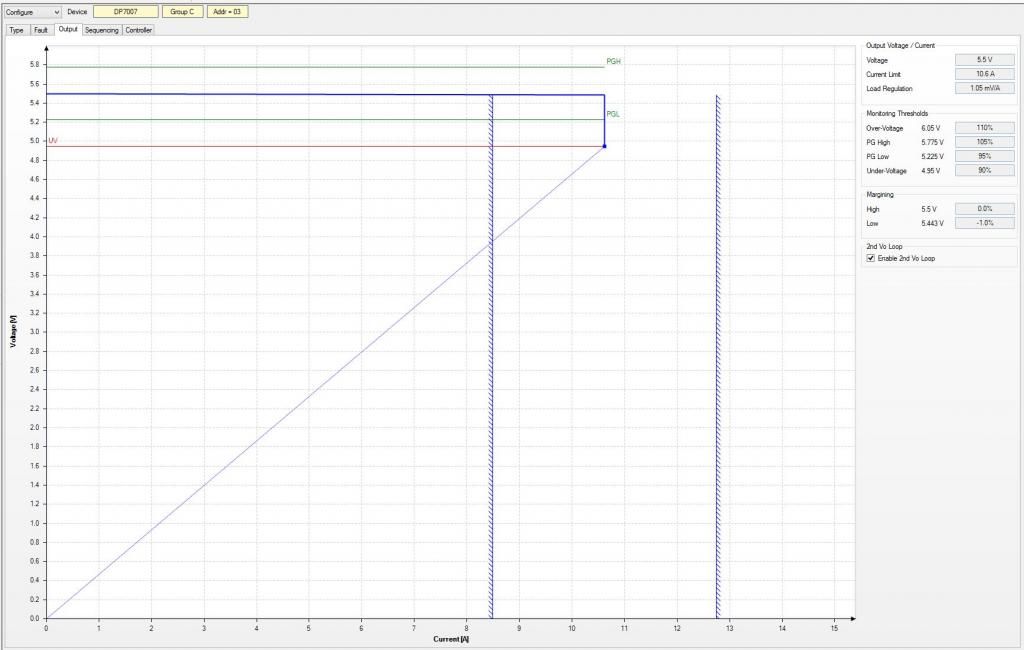
-
Of course...I see the story now.
the HF spike would never be seen at 100Mhz and you would think all is well with the world. BTW, what timebase was the scope on? Is it 1us/div?
It would be such a frustrating scenario when I am experiencing issues on the load, but the scope trace looks perfect at 100Mhz. The cost difference from 100Mhz to 500Mhz is not trivial, but clearly needs some consideration. I am putting financing together for a Pick & Place system, maybe adding a no excuses scope could keep me out of trouble. With all that is going into this effort, it would be criminal to let a glitch sneak by creating some mysterious problem that may never be found.
There are Agilent MSOX3000's in 4ch 500Mhz and 1Ghz nearly 50% off list at the Keysight eBay store. At those prices, I would be foolish to not go big.
-
Of course...I see the story now.
the HF spike would never be seen at 100Mhz and you would think all is well with the world. BTW, what timebase was the scope on? Is it 1us/div?
It would be such a frustrating scenario when I am experiencing issues on the load, but the scope trace looks perfect at 100Mhz. The cost difference from 100Mhz to 500Mhz is not trivial, but clearly needs some consideration. I am putting financing together for a Pick & Place system, maybe adding a no excuses scope could keep me out of trouble. With all that is going into this effort, it would be criminal to let a glitch sneak by creating some mysterious problem that may never be found.
There are Agilent MSOX3000's in 4ch 500Mhz and 1Ghz nearly 50% off list at the Keysight eBay store. At those prices, I would be foolish to not go big.
ABSOLUTELY....that is the point. Do we really want perfect looking traces on our scope? hell NO!!! That is the point of having the scope, after all. I WANT to see problems in the trace, and want to KNOW those problems aren't my probing solution. That is not as simple as one would think, without having the experience in the SPECIFIC application intended.
Is 100MHz front end good enough to see a 20MHz sine wave, from a pristine generator, in a clinical environment? Sure.....but how is that useful to OUR SPECIFIC needs. We need to see reality, and filters and ideal scope traces do the opposite of allowing you to view that reality.
I personally want to make decisions based on the most data possibly available to me. That is how engineering works. It doesn't work on the basis of guesses and simulations. Those predictions and tools are useful, obviously, but don't represent what it takes to ship and warranty a tangible good or service.
I think you have an excellent grasp of what it takes to do this, obviously some other folks do not. I also, obviously, have less of a grasp on YOUR specific use case scenario than you do. Even though my scenarios are similar they are not mirror copies....and we also know that mirror copies (in physics and science) are impossible. That's where I think it's beneficial to look at what myself, and others are saying....and learn enough to make your own value judgements.
My experiment is pretty useful in determining WHY some extra bandwidth is useful. I think it's proof beyond a reasonable doubt.....BUT the specific spec and manufacturer and model (and budget) are almost impossible to make firm statements on.
I personally think the used LeCroy gear is a better value than used Agilent, but that's just some semantics and spin.....as long as the tools do virtually the same thing, then the rest is user preference, and $.
I think the Agilent MSO3k is a bit lacking, in comparison to a windows based solution....especially in tool development....but that's just my opinion.
There are good deals out there, and like I said the extra couple grand you spend now....won't amount to a hill of beans if the product is successful.
If it was me, I would be looking at MSO4k or better, and LeCroy WRXi or better.....I personally went with LeCroy (which replaced the same Agilent hardware we are talking about)
Yes the timebase is 1uS/div....it would only get worse from there.....also it was at a sample rate of 10GS....which is what allows the FFT range out to 5GHz. Obviously we have to have a front end that can capture the HF event to begin with though.
Like I said I could go on and on about how and whyt this is happening, and how to solve it.....but that doesn't lend much insight into scope criteria....and there would of course be my consultation fee
-
reading mr tunersandwich input is very eye opening. and i agree about the extra bandwdth. but for someone going beyond starter scopes, there is just so much to consider
i have been looking at ... many used scopes options. but when i fall on lecroy, i saw some that are year 2006 types ... still with 1.44 floppies ... would you (or anyone) care to give some hints about its ... usability? iirc, its also a 10G/sa. for under USD4k. i am guessing just for the bandwidth, there is no way i can get anything at over 1Ghz nearly as new or usable at under USD4k ... but on the other hand ... these are really old units
-
Oh one VERY important thing to note about FFT results....and I should have mentioned this.
The FFT plot is based on a non-truncated window of the waveform timebase.
Let's break that down.
The timebase of the waveform acquisition window is 1uS/div. The non truncated FFT analysis window spans that ENTIRE timebase. So the FFT result is that of a 10uS timebase, in it's totality.
HOWEVER averaging/persistence was turned on, for the FFT. So the results are across a few minutes of total waveform acquisition. This is how we would test our margining on a POL anyhow.
We want to see it's behavior, across a wide window of time....in relation to frequency and dynamic load changes. This is very key in finding these problems. Understanding the problems? Well that is a discussion for another day......but before we understand anything we have to quantify/define it.....I think our little test here is the beginnings of understanding. It also mirros the WAY in which we ALL quantify and debug potential "problems". Of course determining if a glitch is a "problem" is wholly dependent on the critical nature of your application, or lack of
-
Quote
and there would of course be my consultation fee
Your've earned one with your contribution.
There will be many that find this thread and be grateful.
Thank you for the accolades.
I have always assumed that what i am presenting here is common knowledge. I might be incorrect in that assumption. So if anyone playing along isn't understanding the totality of the experiment....then that is my fault for making assumptions, that everyone doing this has the same level of insight/experience.
That obviously doesn't say it's above or beyond anyones scope (pun) of understanding, but it does say that i need to break down my own assumptions on the level of experience of statements/questions posted here.
There are no bad students.....only bad teachers
-
reading mr tunersandwich input is very eye opening. and i agree about the extra bandwdth. but for someone going beyond starter scopes, there is just so much to consider
i have been looking at ... many used scopes options. but when i fall on lecroy, i saw some that are year 2006 types ... still with 1.44 floppies ... would you (or anyone) care to give some hints about its ... usability? iirc, its also a 10G/sa. for under USD4k. i am guessing just for the bandwidth, there is no way i can get anything at over 1Ghz nearly as new or usable at under USD4k ... but on the other hand ... these are really old units
I wouldn't focus too much on age. If it passes spec....and isn't beat to shit (obviously) then you really only need to look at a few things.
Input bandwidth....sample rate/clock....and sample memory depth. Older units will almost always have "less" total sample memory. That isn't always true though.
The other important aspect is waveform update rate. Especially when dealing with long time divisions.
On a LeCroy having the "wave stream" feature is VERY nice for quick glances at certain problems. It's a very nice persistence tool, available at a button press.
Another key aspect is acquisition modes. Sometimes the averaging and sin x/x interpolation is VERY useful.....and on leCroy units there is also a "hires" mode....which reduces the effective input bandwidth (it's really a noise filter), to give greater vertical resolution.....they claim "interpolated 3 bits".
I am a bit of a "newbie" on LeCroy scopes, so I might not have the most accurate insights into the brand. However I do believe they represent phenomenal value in the used market. I simply could not get a tool, which stitches together post processing blocks, the way LeCroy x-stream engine does. -
well i guess i maybe side tracking the issue of high end scopes, but it wouldnt hurt to ... kinda of compare old lecroys ... to say the current problem the rigol is having : jitter issues? ... im not familiar with anything higher than my 20Mhz analogue. but i sure is a fan of high sample rates (or BW). do high end scopes suffer any kind of bugs?
1 of the things i noticed about lecroy is, it is actually just a XP PC running very dedicated hardware to grab A to D ... so comparatively ... even if i do get something like say an agilent 2xxx series or anything up to a USD 20k unit ... a lecroy 1.5Ghz 10G/sa is still worth so much more @ USD4k right? (and it is 4 channels) ... that "juice" is in its pristine AD and DSP engine ... if its broken in its knobs or whats nots ... those are ... sort of generally cosmetic? yes?
and when you say x stream engine, that would be in their scopes models that are after 2008? (im totally unfamiliar with their tech milestones, but from what im seeing ... it seems they have left the Mhz game a long long long long time ago)
edit : see what i mean?
http://www.ebay.com/itm/Lecroy-WavePro-960-WP960-4-Channel-2-GHz-Digital-Oscilloscope-/271697521072?pt=BI_Oscilloscopes&hash=item3f426f29b0
4kUSD i think will only get a agilent 300Mhz .... *expletives* ... this 1 is 2GHZ !!!
this seller is near me, 14 year old 584, but what i dont know is, how much functions depend on the floppy, and if that FDD could take the "chingchongchang" FDD to SD converter lol
http://www.ebay.com/itm/LECROY-LC584AL-1GHZ-4CH-DIGITAL-OSCILLOSCOPE-2-8-GS-s-/321583104404?pt=BI_Oscilloscopes&hash=item4adfd8c194
http://www.kustompcs.co.uk/acatalog/5421.jpg
edit :: aha ... new knowledge ... so the actual effective sample rate is around 500MS/s ...
-
well i guess i maybe side tracking the issue of high end scopes, but it wouldnt hurt to ... kinda of compare old lecroys ... to say the current problem the rigol is having : jitter issues? ... im not familiar with anything higher than my 20Mhz analogue. but i sure is a fan of high sample rates (or BW). do high end scopes suffer any kind of bugs?
1 of the things i noticed about lecroy is, it is actually just a XP PC running very dedicated hardware to grab A to D ... so comparatively ... even if i do get something like say an agilent 2xxx series or anything up to a USD 20k unit ... a lecroy 1.5Ghz 10G/sa is still worth so much more @ USD4k right? (and it is 4 channels) ... that "juice" is in its pristine AD and DSP engine ... if its broken in its knobs or whats nots ... those are ... sort of generally cosmetic? yes?
and when you say x stream engine, that would be in their scopes models that are after 2008? (im totally unfamiliar with their tech milestones, but from what im seeing ... it seems they have left the Mhz game a long long long long time ago)
edit : see what i mean?
http://www.ebay.com/itm/Lecroy-WavePro-960-WP960-4-Channel-2-GHz-Digital-Oscilloscope-/271697521072?pt=BI_Oscilloscopes&hash=item3f426f29b0
4kUSD i think will only get a agilent 300Mhz .... *expletives* ... this 1 is 2GHZ !!!
Absolutely a "high end" DSO can suffer from software/firmware bugs.....it's still a digital system (at heart). I would expect a reputable, high dollar, brand name to do some better testing on their hardware, but that isn't always the case.
The lecroy unit you posted is NOT running the x-stream engine. It is lecroys own dedicated OS (I am not fully educated in those older models).
Obviously a front end bandwidth is what it is....BUT we also have to consider the processing behind it....and if it's up to the task of fully resolving analogue events on the input a/d.
it seems lecroy has invested more in user interface, than most other brands.....their MAUI touch software is truly leagues ahead of others. It even makes touch use on win XP totally workable.
it also seems lecroy is focusing efforts on high vertical resolution scopes (which is AWESOME). they do still make some of the absolute highest bandwidth lab scopes in the market.....
I believe that lecroy represents the best value in the used market....especially for those looking at post processing operations and interface/tool development.....
I could write a few books on the features I have discovered and used, in the wr64MXi, I only recently acquired.
I also believe (opinion) LeCroy has the edge (higher end models) in triggering. Hands down the best triggering systems i have ever used in a scope. They simply put to shame even Agilents "ultra high end" models.
I am currently considering the HDO8k from LeCroy. That's how impressed I have been with my used WR64MXi acquisition. I personally wouldn't hesitate to buy LeCroy again, despite the new values being a bit "overinflated" (IMO).
Used, it's a no brainer.....feature set to feature set the lecroy I have, from 2009....still out classes anything offered from Agilent....
The downside is the lower waveform update rate, and memory depth.....neither of which bothers me very much....
-
1 of the things i noticed about lecroy is, it is actually just a XP PC running very dedicated hardware to grab A to D
Not necessarily. Newer scopes (using technology LeCroy calls 'X-Stream') are running Windows (W2k, XP, Vista, 7 depending on the model). X-Stream was introduces with the WaveMaster 8000 IIRC in 2002, followed by the WavePro 7000 and WaveRunner 6000 in 2003 and 2004.
The predecessor scopes (WaveRunner LT, WaveRunner2 LT, WavePro 900, mostly made between 1998 and 2003) use a PowerPC processing system and run VxWorks as OS. These are still great scopes, though, and offer many advanced capabilities, although they lack the touchscreen interface (MAUI) of the X-Stream scopes. These scopes were made by Iwatsu (although designed by LeCroy), which means the build quality is excellent.
The even older scopes were the 9300 Series (mono CRT, 1994-1997), followed by the LC Series (LC 300/500 with color CRT, LC 600 with TFT, all between 1998-2000). These scopes run some old proprietary OS which is more limited than VxWorks in the later models. The 9300 has a 68k processing system, the LC is PowerPC. The build quality isn't half as good as the later Iwatsu-made scopes, Unless you're into collecting old scopes, I would not invest any money in them.
Before the 9300 there were the 9400 and 7200 Series, both roughly from the late 80's to the early 90's. Same here, unless you're into vintage scopes, avoid.
All the listed non-Windows scopes (9300, LC, WaveRunner LT, WaveRunner2 LT, WavePro 900) use the same user interface. 9400 and 7200 have a different UI, though, much simpler (obviously).Quote... so comparatively ... even if i do get something like say an agilent 2xxx series or anything up to a USD 20k unit ... a lecroy 1.5Ghz 10G/sa is still worth so much more @ USD4k right? (and it is 4 channels) ... that "juice" is in its pristine AD and DSP engine ... if its broken in its knobs or whats nots ... those are ... sort of generally cosmetic? yes?
There's no "DSP engine". All processing in LeCroy scopes is done by the 68k/PowerPC/x86/x64 "PC". In fact, X-Stream does all calculations in the very fast CPU cache, not in main memory as other scopes do.Quoteand when you say x stream engine, that would be in their scopes models that are after 2008? (im totally unfamiliar with their tech milestones, but from what im seeing ... it seems they have left the Mhz game a long long long long time ago)
See above.Quoteedit : see what i mean?
http://www.ebay.com/itm/Lecroy-WavePro-960-WP960-4-Channel-2-GHz-Digital-Oscilloscope-/271697521072?pt=BI_Oscilloscopes&hash=item3f426f29b0
4kUSD i think will only get a agilent 300Mhz .... *expletives* ... this 1 is 2GHZ !!!
Absolutely overpriced! For a WavePro 960 I wouldn't pay more than $2k-$2.5k. For around $4k you can often get a WavePro 7200/7300 (2Ghz/3Ghz) which is a newer X-Stream scope. I didn't pay much more than the asking price in that auction for my WP7300A (made in 2008), and that came with all the software options.Quotethis seller is near me, 14 year old 584, but what i dont know is, how much functions depend on the floppy, and if that FDD could take the "chingchongchang" FDD to SD converter lol
http://www.ebay.com/itm/LECROY-LC584AL-1GHZ-4CH-DIGITAL-OSCILLOSCOPE-2-8-GS-s-/321583104404?pt=BI_Oscilloscopes&hash=item4adfd8c194
The asking price for that thing is even more ridiculous than the first one. These scopes regularly go for way below $1k.
And btw, it's not 'just' 14 years old, more like 15+ (the sticker on the back says made in 1999). Don't bother with it, really.
These scopes were great at their time, but the color CRT is a pain in the arse, and the newer VxWorks scopes are much better anyways.
Especially if it's for professional use, I'd either get a X-Stream scope (WaveRunner, WavePro) or a VxWorks-based scope (WaveRunner2 LT or WavePro 900, don't bother with the WaveRunner LT), depending on your budget.
-
The downside is the lower waveform update rate
The (M)Xi Series is spec'd for a max wfm rate of 1.25M waveforms/sec, but I don't know in what configuration this is. -
The downside is the lower waveform update rate
The (M)Xi Series is spec'd for a max wfm rate of 1.25M waveforms/sec, but I don't know in what configuration this is.
It gets really dodgy under heavy processing and long time bases. I think that is more an issue of the GPU/OS side of things though....not sure how that waveform rate is calculated (since it's dependent on an SoC GPU host)....
I have been running my MXi with the outer plastic case off the back.....that dropped temps by orders of magnitude....which lowered the CPU load (goddamn thermal provisioning/stepping). It still needs a better cooling solution. Quite disappointing in that regard.
On a side note I scored an un-used LeCroy motherboard/cpu/ram etc assembly (MX855LC)....for $50!!! I might just whack that into a case and do some experimenting with it. -
It gets really dodgy under heavy processing and long time bases. I think that is more an issue of the GPU/OS side of things though....not sure how that waveform rate is calculated (since it's dependent on an SoC GPU host)....
I have been running my MXi with the outer plastic case off the back.....that dropped temps by orders of magnitude....which lowered the CPU load (goddamn thermal provisioning/stepping). It still needs a better cooling solution. Quite disappointing in that regard.
As said before I think there's something dodgy with your particular setup. My 64Xi with 1.8Ghz processor gets barely hand warm, and I know that the cooling is perfectly adequate for the 2GHz processor LeCroy offers as an upgrade for these scopes.QuoteOn a side note I scored an un-used LeCroy motherboard/cpu/ram etc assembly (MX855LC)....for $50!!! I might just whack that into a case and do some experimenting with it.
Nice catch! -
Hoe much more specific do you need this to get? Just because you don't understand the results....doesn't mean the problem is on MY end....like I said you are throwing generalizations out, with NO data to back them up.....on a VERY specific subject....here is your overshoot
I go with what I see and that is that your multimeters are showing 5.50V like you expected. I also see an oscilloscope image with C3 set to 20mV/div and a relatively clean trace with some spikes but they all stay within 20mVpp. The offset is adjusted to -5.29V in order to see the trace at 20mV/div.
In this picture you can clearly see the circled are of the FFT (to the left) which the simulator predicted.....(have a look at the response charts again if you missed it). On the right you can clearly see HF content that was not predicted. In the waveform you can clearly see that the HF content is causing the control loop (vsense coupling) to cause a switching overshoot, that measures ABOVE the predicted range in the simulation...the ripple shown, which is more frequent (brighter part of the trace) is well within the spec of the system......the overshoot event is NOT....and if I didn't loosen up the over provisioning specs in the controller, it would have caused the entire system to turn the POL off....
 Quote
QuoteSo then why does our scope pick-up 5.55044 V peak? Despite the POL margining the output above 9 amps?
There is a simple answer to that: If I look up the DC accuracy specs(*) of the 64MXi I see that it has a DC accuracy of 1.5%. At 5.5V that is already an uncertainty of +/-82mV. As a rule of thumb you can't use an oscilloscope for really accurate DC or amplitude measurements. For such measurements a DC or AC voltmeter are much better tools. IMHO Lecroy shows too many meaningless digits in the result.
BTW: IMHO the HF content could be GSM interference. It matches some GSM frequency bands perfectly. The same goes for the HF on the left. It matches the frequencies used for FM radio too perfect to be a coincidence.
* http://www.testequipmenthq.com/datasheets/LECROY-WAVERUNNER%2064MXI-Datasheet.pdf -
I go with what I see and that is that your multimeters are showing 5.50V like you expected. I also see an oscilloscope image with C3 set to 20mV/div and a relatively clean trace with some spikes but they all stay within 20mVpp. The offset is adjusted to -5.29V in order to see the trace at 20mV/div.
QuoteSo then why does our scope pick-up 5.55044 V peak? Despite the POL margining the output above 9 amps?
There is a simple answer to that: If I look up the DC accuracy specs(*) of the 64MXi I see that it has a DC accuracy of 1.5%. At 5.5V that is already an uncertainty of +/-82mV. As a rule of thumb you can't use an oscilloscope for really accurate DC or amplitude measurements. For such measurements a DC or AC voltmeter are much better tools. IMHO Lecroy shows too many meaningless digits in the result.
BTW: IMHO the HF content could be GSM interference. It matches some GSM frequency bands perfectly. The same goes for the HF on the left. It matches the frequencies used for FM radio too perfect to be a coincidence.
* http://www.testequipmenthq.com/datasheets/LECROY-WAVERUNNER%2064MXI-Datasheet.pdf
The DC accuracy is dependent on probing solution, as well as mode dependencies.
You also do realize that the accuracy stated on the data sheet is for full scale right? I assume you do understand what "full scale" means?
The scope shows accuracy acceptable, for this test....when connected to my 5 V ref.
The probes were tested prior....to verify that no HF artifacts were present.
You can't see the entirety of the switching pulse peak, at this timebase, or lack of photo resolution.
The DMM averaging is on DC....
I can guarantee you where the fault is coming from, because I purposely injected it into the test. With the fault removed, the regulation is stable and within spec. The fault is in the control loop (which the DMM's were measuring....you don't seem to get what a V-sense control loop is).
I seem to remember you saying earlier in this thread, that the scope probes don't matter....and a differential/active etc probe is unnecessary. Now you are saying that the HF energy is common mode noise....from RF.
So which one is it...?
DMM's don't show fast transients.
I will ask the question again. Can you give anyone here a reason why a recommendation for bandwidth (above 100MHz) is, or is not, necessary to analyze critical step responses in DC-DC (switch-mode) converters?
Common knowledge, and this simple experiment says you buy as much bandwidth as you can afford.
Do you have a solid grasp on resonant interactions between external capacitance and dc-dc control loops? I ask because I do, and you are missing some very key points about the hows and whys of their operation...and potential problems. As well as the tools used to diagnose and solve such problems.
The HF content on the left is exactly predicted by the simulation....
I don't think you are reading or observing the simulation screens....or looking at the clearly stated set points for the controller. Which makes arguing with you about this VERY frustrating, because you are trying to explain something away, that is real...and clearly shown in all of the data presented.
If you simply want to argue, to try and justify your points (which aren't accurate or based on observation) then please do so with someone else. I am not willing to have a debate, with someone who is ignoring data and trying to nitpick on topics that aren't being understood (by you). It seems when you are confronted with more data and explanation, you try to find an even more esoteric and un-tested theory as to why you simply can't be wrong (about this topic). It's not helping anyone here...
First you said my simulation is incomplete (based on assumption). I posted the complete (as you can see VERY complete) simulation parameters. So rather than offering any kind of positive statement or apology you just jump to another point, which is invalid, so you can continue to find fault...that doesn't exist.
meh....enough time wasted....the data is there....take it for what it's worth...or don't. -
It gets really dodgy under heavy processing and long time bases. I think that is more an issue of the GPU/OS side of things though....not sure how that waveform rate is calculated (since it's dependent on an SoC GPU host)....
I have been running my MXi with the outer plastic case off the back.....that dropped temps by orders of magnitude....which lowered the CPU load (goddamn thermal provisioning/stepping). It still needs a better cooling solution. Quite disappointing in that regard.
As said before I think there's something dodgy with your particular setup. My 64Xi with 1.8Ghz processor gets barely hand warm, and I know that the cooling is perfectly adequate for the 2GHz processor LeCroy offers as an upgrade for these scopes.QuoteOn a side note I scored an un-used LeCroy motherboard/cpu/ram etc assembly (MX855LC)....for $50!!! I might just whack that into a case and do some experimenting with it.
Nice catch!
Heads up on the hybrid HDD by the way. It looks like the MBR is somehow corrupted. It failed to boot today. I am setting up a recover console to run some dsk utilities. I suppose I am just going to stick a "normal" magnetic (higher RPM) drive in there. Your experience with SSD corruption, and now mine with SHDD makes me lean towards just sticking to the magnetic drives.
I am going to get back into that MOBO and have a look at the heatsink. It's entirely possible that something is not right there (can't imagine what).
Without a doubt my scopes behavior seems a bit off, since the CPU change. -
By the way....just in case anyone wants to know the true accuracy potential of a scope here are some pictures....
Let's also clarify what the term "full scale" means....when relating to accuracy criteria.
My scope has a claimed DC accuracy of "±1.0% of full scale (typical); ±1.5% of full scale?10 mV/div (warranted)"
If my vertical scale is 20mV/div and my full scale is 8 div...my "full scale" = 160mV
if my full scale accuracy is 1.5% (+/-)....my accuracy is +/- 2.4mV (full scale)....and chances are those figures are reported using the kit probes. The probe in test (FET) is going to yield even better results...in terms of true accuracy from the load (probe tip) to input (scope input amplifier)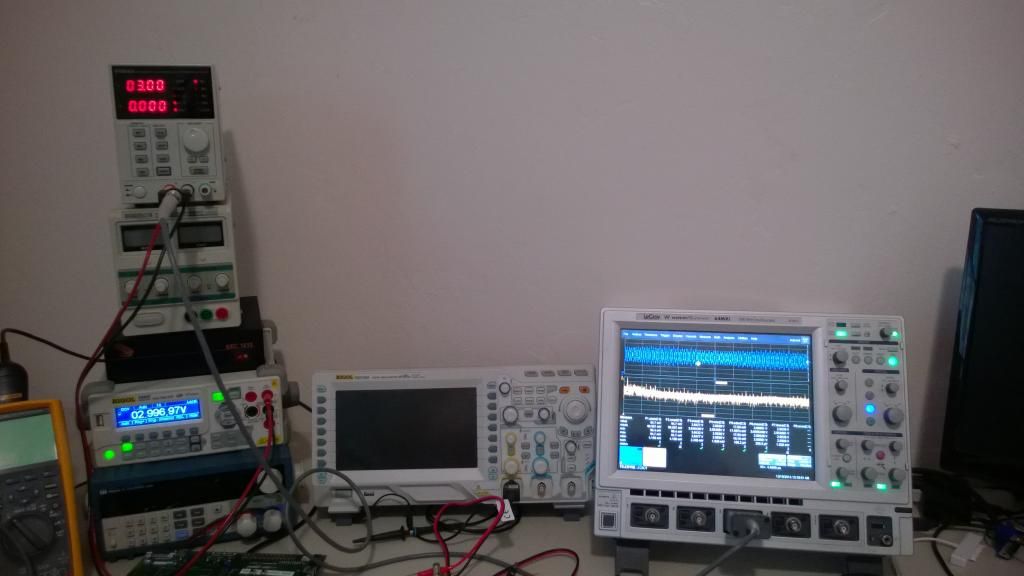
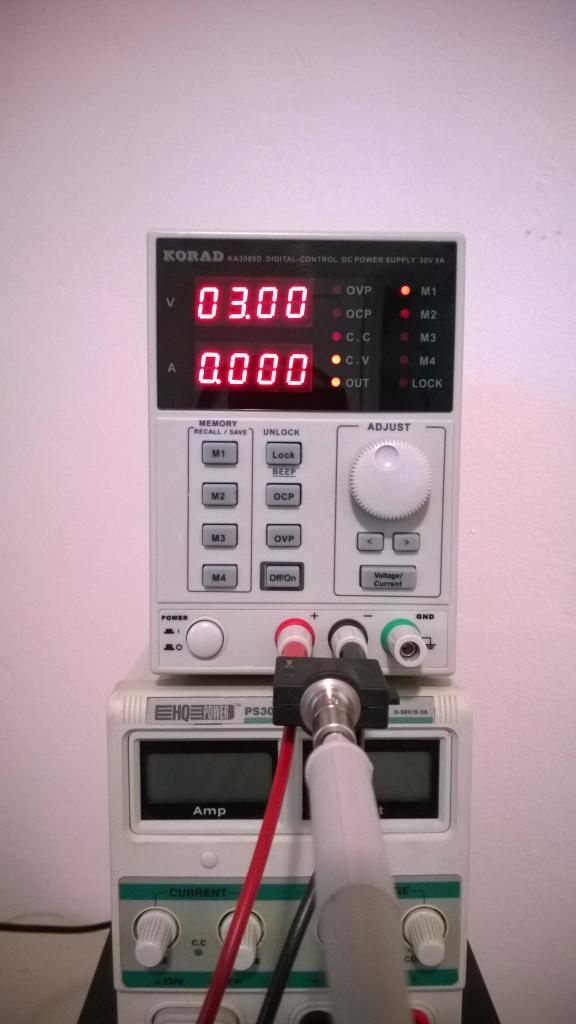
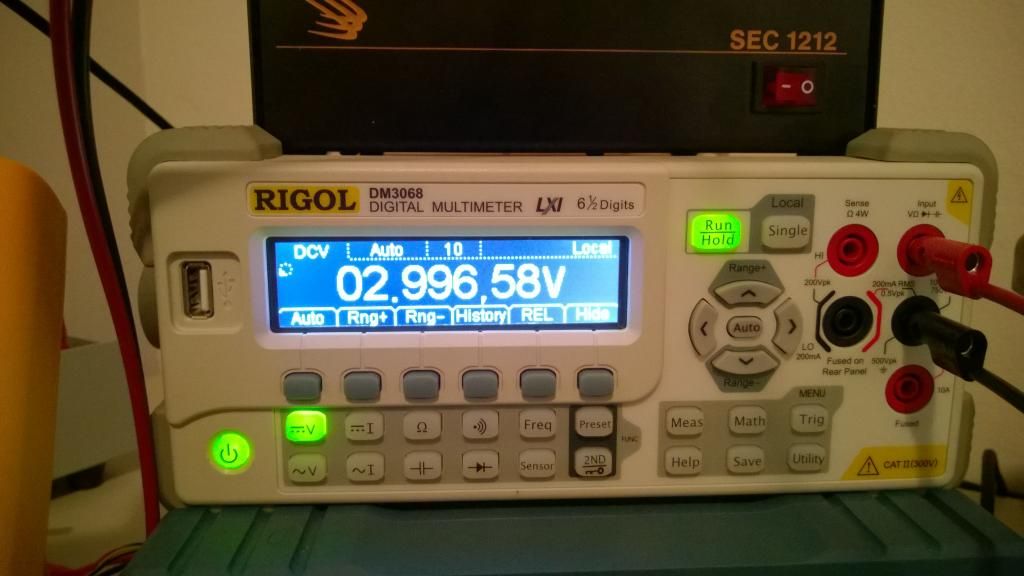
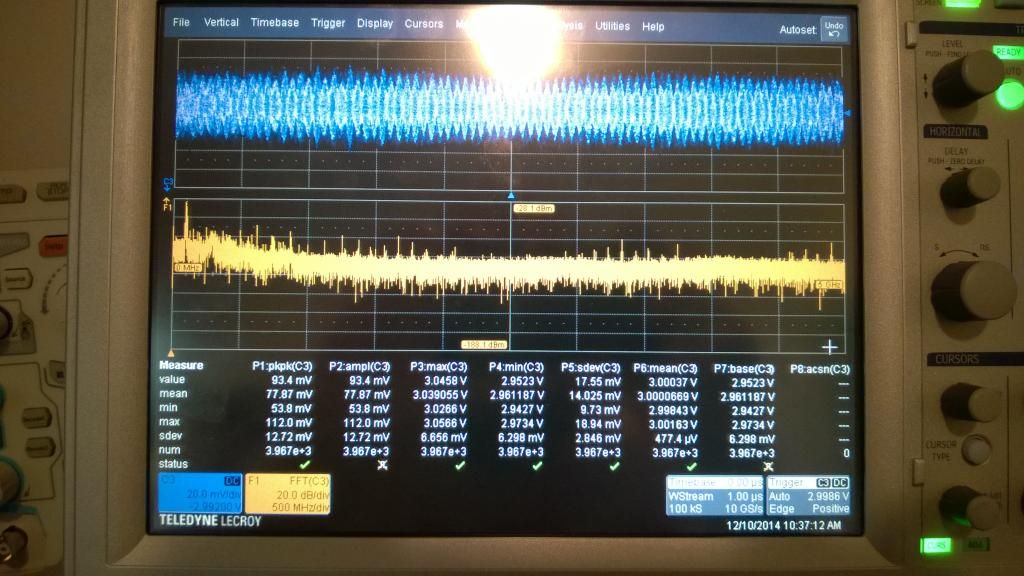
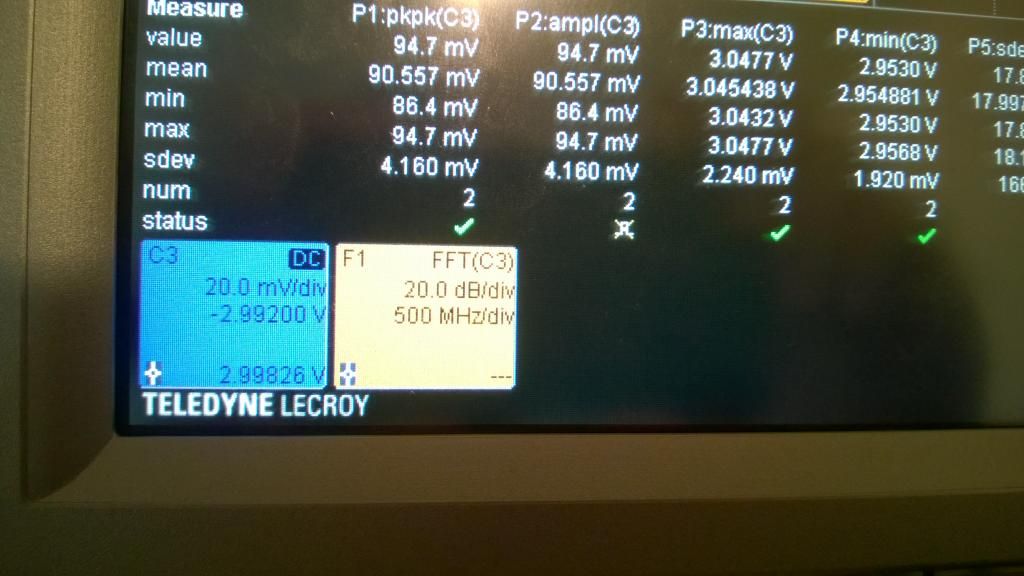
That sure as hell doesn't look like a discrepancy of "82mV" to me.....
